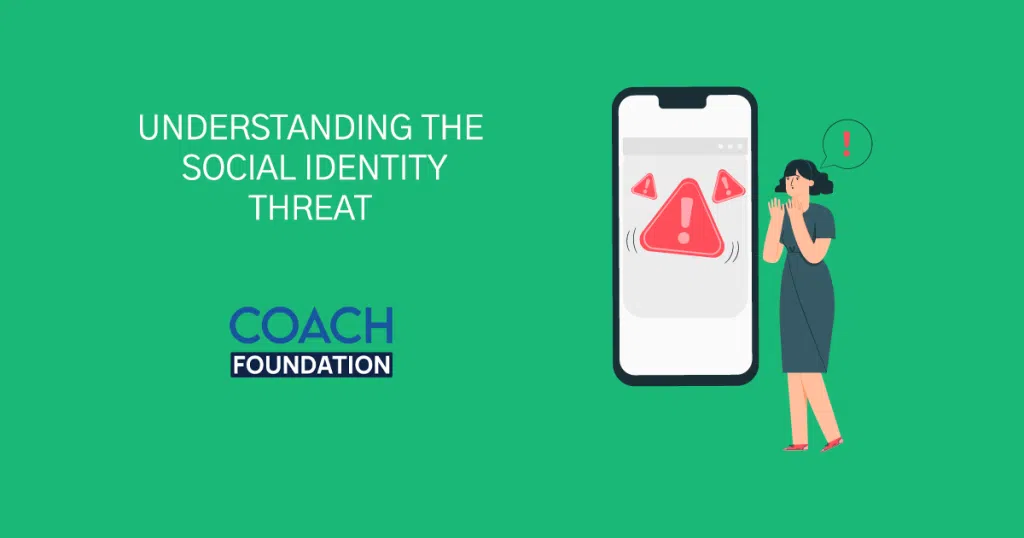Understanding The Social Identity Threat
Social identity threat is a psychological experience where a person feels that their identity is being negatively stereotyped or devalued. It can be a useful technique to learn as a life coach. This can occur in a variety of contexts, such as race, gender, sexual orientation, or any other group membership that is important to an individual.

In this article, we will explore the core concepts of social identity threat, its various types, and the factors that affect it.
We will also examine the cognitive, emotional, and behavioral effects of the social identity threat and how they can be applied to life coaching.
- Understanding The Social Identity Threat
- What is the Social Identity Threat?
- How does the social identity threat work?
- Core Concepts of Social Identity Threat
- Types of Social Identity Threat
- Moderating Factors that Affect Social Identity Threat
- Effects of Social Identity Threat
- Applying Social Identity Threat to Life Coaching
- Conclusion
- Frequently Asked Questions (FAQs)
What is the Social Identity Threat?
The social identity threat is a phenomenon that occurs when individuals perceive a potential threat to their social identity.
Social identity refers to the part of an individual’s self-concept that is derived from their membership in a particular social group.
This can include groups based on race, ethnicity, gender, sexual orientation, religion, and many other factors.
The social identity threat occurs when individuals feel that their group membership is being negatively stereotyped, devalued, or marginalized in a particular context. This can lead to increased anxiety, decreased performance, and other negative outcomes.
Research has shown that the social identity threat can impact individuals from a variety of groups and can occur in a variety of contexts.
For example, students from underrepresented racial or ethnic groups may experience social identity threats in academic settings due to negative stereotypes about their group’s intellectual abilities.
Similarly, individuals who identify as LGBTQ+ may experience a social identity threat in social settings where they feel that their sexual orientation is stigmatized or devalued.
It’s important to recognize that the social identity threat can have significant negative impacts on individuals’ psychological and physical well-being, as well as their performance and outcomes in various domains.
As such, it’s important for coaches to be aware of the social identity threat and to help their clients develop strategies for coping with it.
If you’re interested in some visual information, here is a video that can help you learn more.
How does the social identity threat work?
The social identity threat works by impacting individuals’ cognitive, emotional, and behavioral responses to a particular context.
When individuals perceive a potential threat to their social identity, this can activate a range of cognitive processes that can impact their performance and outcomes.
One way that the social identity threat works is through increased anxiety and stress. When individuals feel that their group membership is being devalued or marginalized in a particular context, this can lead to increased anxiety and stress, which can impair their cognitive functioning and performance.
Additionally, the social identity threat can impact individuals’ cognitive processing and self-evaluation. When individuals perceive a threat to their social identity, this can activate negative stereotypes and biases that are associated with their group membership.
These negative stereotypes and biases can impact individuals’ self-evaluation and lead to decreased confidence and motivation.
Core Concepts of Social Identity Threat
The core concepts of social identity threat include group membership, stereotype activation, and self-esteem.
Group membership refers to the particular social group that an individual identifies with.
Stereotype activation occurs when negative stereotypes associated with a group are activated in a particular context. Self-esteem refers to an individual’s overall sense of worth and belonging.
Types of Social Identity Threat
There are three main types of social identity threats: stereotype threat, prejudice threat, and discrimination threat.
1. Stereotype Threat
Stereotype threat occurs when a person is aware of a negative stereotype associated with their group membership and fears that they will be judged based on that stereotype. This can lead to decreased performance and increased anxiety.
For example, a black student may experience stereotype threat when taking a test that is associated with academic intelligence. This is because there is a negative stereotype that black individuals are less intelligent than other racial groups.
2. Prejudice Threat
A prejudice threat occurs when a person perceives that they are being discriminated against based on their group membership. This can lead to increased stress and anxiety, decreased performance, and feelings of anger and resentment.
For example, a Muslim individual may experience prejudice when traveling through an airport where there is increased security screening for people who appear to be of Middle Eastern descent.
3. Discrimination Threat
A discrimination threat occurs when a person experiences actual discrimination based on their group membership. This can lead to feelings of anger, frustration, and a lack of trust in others.
For example, a woman may experience discrimination threats when she is passed over for a promotion at work because of her gender.
Moderating Factors that Affect Social Identity Threat
Several factors can moderate the effects of social identity threats. These include group membership, individual differences, and contextual factors.
1. Group Membership
Group membership can moderate the effects of social identity threat. For example, if an individual strongly identifies with a particular group, they may be more likely to experience social identity threats in situations where that group is negatively stereotyped or devalued.
2. Individual Differences
Individual differences can also moderate the effects of social identity threats. For example, individuals who have higher levels of self-esteem or who are more resilient may be less affected by social identity threats than those who do not.
3. Contextual Factors
Contextual factors can also moderate the effects of social identity threat. For example, if an individual is in a supportive environment where their identity is valued and respected, they may be less likely to experience social identity threats.
Effects of Social Identity Threat
Social identity threats can have a variety of effects on individuals, including cognitive, emotional, and behavioral effects.
1. Cognitive Effects
Social identity threats can lead to decreased cognitive performance, such as decreased test scores or decreased problem-solving abilities. This is due to the possibility that people who are experiencing social identity threats may become preoccupied with worrying and negative thoughts about their group membership.
2. Emotional Effects
Social identity threats can also have emotional effects, such as increased anxiety, stress, and feelings of insecurity. Individuals who are experiencing social identity threats may also feel disconnected from their group and have a decreased sense of belonging.
3. Behavioral Effects
Social identity threats can also have behavioral effects, such as decreased motivation or avoidance behaviors. For example, an individual who is experiencing social identity threats may be less motivated to engage in activities or tasks that are associated with their group membership.
Applying Social Identity Threat to Life Coaching
As a coach, it’s important to understand the social identity threat and how it can affect your clients. You can help your clients by creating a supportive environment where their identity is valued and respected.
You can also help your clients recognize and challenge negative stereotypes and biases that are associated with their group membership.
Additionally, you can work with your clients to develop resilience and coping strategies to help them manage the effects of social identity threats.
This may involve helping your clients develop a more positive self-concept and build a stronger sense of belonging within their group.
Conclusion
Social identity threat is a psychological experience where a person feels that their identity is being negatively stereotyped or devalued.
This can lead to increased stress and anxiety, decreased performance, and a feeling of disconnection from the group.
Understanding the social identity threat and its various types and effects is important for coaches who want to create a supportive environment for their clients.
Frequently Asked Questions (FAQs)
What is the concept of social identity threat?
Social identity threat is a psychological experience where a person feels that their identity is being negatively stereotyped or devalued in a particular context.
This can lead to increased stress and anxiety, decreased performance, and a feeling of disconnection from the group.
What are a few examples of social identity threats?
Some examples of social identity threats include stereotype threats, prejudice threats, and discrimination threats.
For example, a black student may experience stereotype threat when taking a test that is associated with academic intelligence.
This is because there is a negative stereotype that black individuals are less intelligent than other racial groups.

ABOUT SAI BLACKBYRN
I’m Sai Blackbyrn, better known as “The Coach’s Mentor.” I help Coaches like you establish their business online. My system is simple: close more clients at higher fees. You can take advantage of technology, and use it as a catalyst to grow your coaching business in a matter of weeks; not months, not years. It’s easier than you think.
AS SEEN ON






